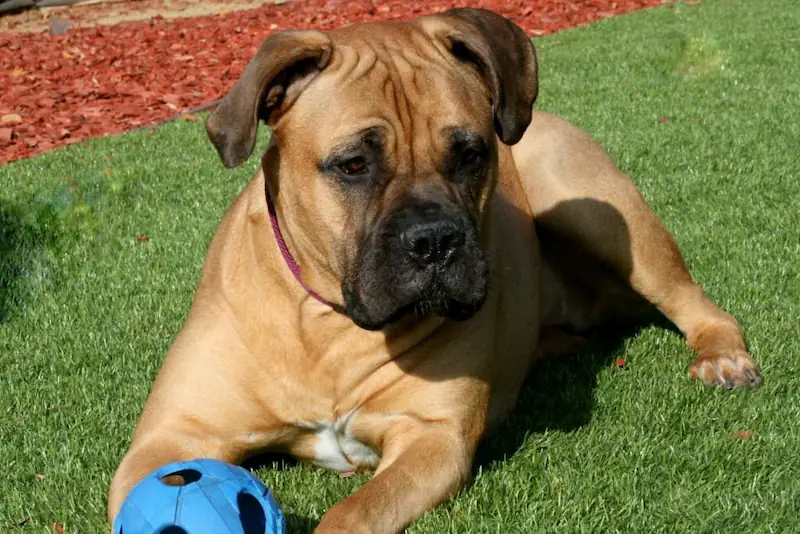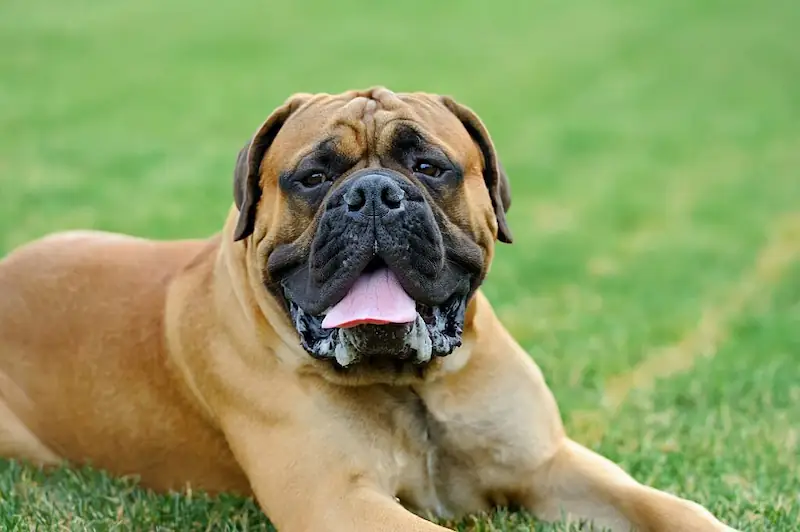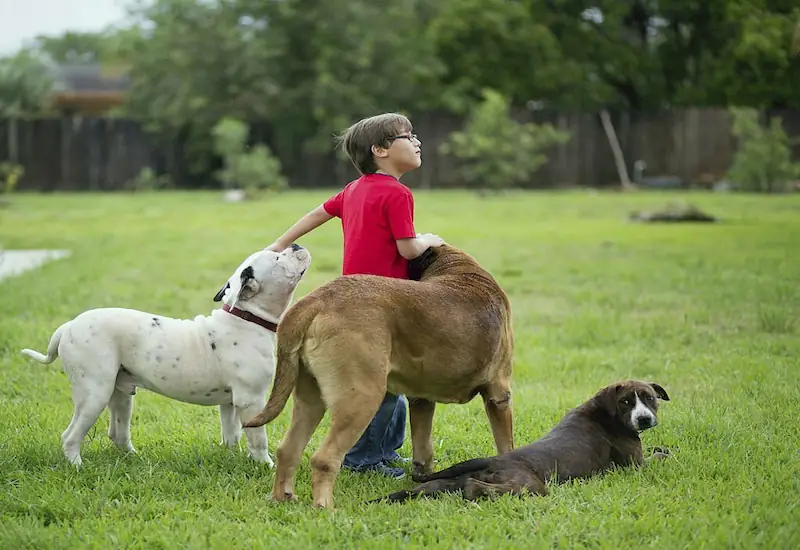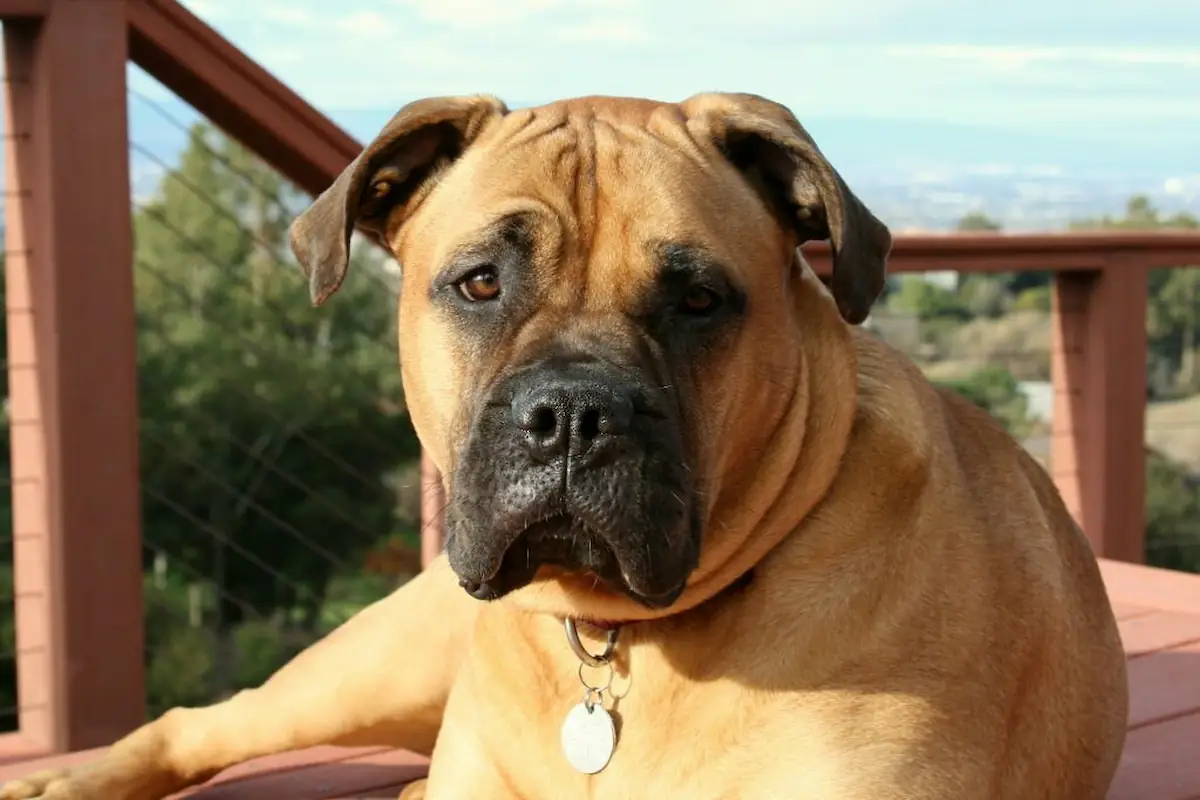Oh, the affable Bullmastiff. This dog is a gentle giant who is ideal for someone seeking a dependable guard dog. They’ll protect you as needed, as well as be willing to recline with you on the sofa during a lazy day.
This dog breed is part of the working group. After they are socialized — they require many puppy sessions! — they will be good with your entire family, children included. However, Bullmastiffs do not like other dogs all the time, yet if they can be with them for long periods, they could be friends eventually.
The assured and reliable Bullmastiff can seem intimidating, mainly because they are a chunky mixture of a Mastiff and a Bull Dog. This is the reason they make fantastic guard dogs. They don’t bark at strangers. Instead, they track them, and then alert their owners to the possible threat. Wow, they are great dogs.
The Bullmastiff has an official nickname, which is “The Gamekeeper’s Watch Dog. “
Related also: The American Mastiff – History and Owners Guide
Background: Roots of the Bullmastiff

Bullmastiffs started being bred in England during the 1800s as guard dogs. Like their name says, these dogs are a mix of a bulldog and a mastiff. Gamekeepers developed them so they could guard their large estate properties. Since they are a mix of two quite strong kinds of dogs, it’s all you’d ever want in a guard dog. They are fast, self-confident, and strong by nature. The thing that makes Bullmastiffs stand out is they never bark! They are known as a silent tracker.
Bullmastiffs came to the US through John D. Rockefeller, as he had one that guarded his estate in Tarrytown, New York.
Bullmastiff Size – Inches at the Shoulder

Bullmastiffs are not as large as other Mastiffs since they are mixed with a tinier dog breed (the bulldog). They typically stand around two feet tall and may weigh up to a hundred pounds. They tend to be very large and pretty stocky and have a broad head.
Related also: Tosa Inu: Everything You to Know about Owning a Japanese Mastiff
How heavy does a Bullmastiff get?
Although smaller than other Mastiffs, the bullmastiff is a large dog. Male Bullmastiffs might weigh between 110 and 130 pounds, while females typically weigh between 100 and 120 pounds.
Bullmastiff Personality

The Bullmastiff is a loving and loyal dog. Since they were meant to be guard dogs, that makes them exceptionally loyal to owners. They additionally tend to be somewhat sedentary, and thus they adore spending a relaxing time with their people. They are brilliant and self-confident and wish to please their masters.
While they tend to get on wonderfully with everyone, these dogs do need to be socialized early in their lives to make sure they can accept a stranger if you want them to do so.
Intellect / Trainability
You can’t skip out on the Puppy classes if you own a Bullmastiff. They’re stubborn yet smart. Thus if they are not adequately trained, they will not be correctly socialized. After you get your Bullmastiff all trained and set up a proper routine, you ought to be good to go. They are certainly trainable dogs since they want to make people happy.
Top Training Methods For Bullmastiffs
A Bullmastiff should attend puppy classes. Then an expert can help your dog get socialized around other people and dogs. This expert will assist you in understanding the best things to do to keep your pup under control. Then you’ll have a fantastic working relationship all through their lives. The Bullmastiff intends to obey you and satisfy you; however, you must take the first step and put them into puppy training classes.
Perfect Environment
There are several options to house your Bullmastiff. They are not incredibly active pups. Therefore they would not despise living in an apartment. They’re okay with merely taking a little walk daily so they can get out and about. However, Bullmastiffs are also willing to lay around the house with you too.
On the other hand, they’d likewise enjoy living somewhere that has more room. However, if you plan on leaving a Bullmastiff outside without supervision, be sure your yard has a fence around it. Since the breed naturally is very protective and quite strong, these dogs can escape and possibly cause hurt to someone who gets too close to their home if they don’t know them.
If you have a fenced-in yard, and it’s a strong fence, a Bullmastiff should be happy to stay there.
Is a Bullmastiff great for families and children?

Bullmastiffs can get on with anyone after being socialized. They adore people! They are loyal to their people, no matter who they are. And indeed, they are okay with children whenever they know them. They are powerful dogs, however, and at times do not know their own strength. Therefore, you should always be around when these dogs are intermingling with kids to ensure everyone gets treated with respect (obviously, that is valid for any dog!).
Related also: Dogo Argentino – Owner’s Guide to the Giant Argentinian Mastiff
Average Life Span
Due to their size, sadly, Bullmastiffs don’t live a long time. Usually, it is around seven to nine years.
Bullmastiff Health Outlook
Bullmastiffs tend to be a very healthy breed. They sometimes have some commonplace health issues. For instance, any dog can get cancer. Bullmastiffs who develop cancer usually develop lymphosarcoma, hemangiosarcoma, and osteosarcoma.
One more health problem your dog could end up with is elbow or hip dysplasia. For both these joint problems — which happen more often in large-breed dogs — their ball and socket do not fit together correctly, so it causes pain and other issues with their movement.
Hip dysplasia is inherited. Although AKC-certified purebred Bullmastiffs get tested to see if they have it before getting bred, therefore you should not have to be concerned regarding buying a purebred Bullmastiff pup that has hip dysplasia.
One more health problem they could develop is entropion. It affects the eyes and typically can be discovered early in a dog’s life. Entropion happens when the eyelids roll in, and this irritates the eyeballs. If your pup seems to mess with their eyes all the time, look carefully to see if you notice anything wrong. Entropion can be fixed via surgery.
Energy Level
Bullmastiffs tend to be calm dogs. While they love to play a little, they are mainly okay with just a single daily walk. Do not expect these dogs to be a running partner. If you are active, this isn’t the dog for you. Clearly, a dog’s activity level varies for each pup, but typically, they are a pretty calm breed.
Are Bullmastiffs friendly around other dogs?
Since Bullmastiffs are very protective, It is not unusual for one to be sensitive toward another dog. They are inclined to prefer dogs of the opposite sex, plus do better if you socialize them alongside other dogs from puppyhood.
Related: All 20 Types of Mastiff Breeds
Are they kind to outsiders?
Bullmastiffs watchdogs, so, they do not always accept strangers, as they may see them as a danger. Obviously, with the appropriate training and socialization, that can be alleviated, but it is something you should know.
Cat or Other Kinds of Pets?
If you have socialized your Bullmastiff around cats from puppyhood, odds are they will be okay around them. Like with children and people, It all depends on how well the dog is socialized in its puppyhood.
Coat and Grooming
Bullmastiffs are short-haired, so their coat is easy to maintain. Bath them if needed, and a groomer can help you control their shedding. After that, they are all set.
Conclusion: Bullmastiff Dog Breed
In conclusion, Bullmastiffs are a remarkable breed that combines strength, loyalty, and affection. Understanding their needs and characteristics is crucial for providing them with a loving and suitable home.
FAQs About Bullmastiffs:
Are Bullmastiffs good with children?
Yes, Bullmastiffs are known for being good with children, thanks to their gentle and protective nature.
How much exercise do Bullmastiffs need?
Bullmastiffs require moderate exercise, including daily walks and playtime, to keep them healthy and happy.
Do Bullmastiffs drool excessively?
While they may drool, it’s not excessive compared to some other large breeds.
Are Bullmastiffs easy to train?
Training a Bullmastiff requires patience and consistency, but they respond well to positive reinforcement techniques.
What is the average lifespan of a Bullmastiff?
The average lifespan of a Bullmastiff is around 8 to 10 years, depending on various factors like genetics and overall health.
What are the characteristics of a Bullmastiff dog?
The Bullmastiff is a compact, strong, and muscular dog, with a large, square head. The fur is short, hard, and weather-resistant, so it does not require much effort to keep clean. They are fearless, affectionate, and loyal protectors, but do not like excessive exercise.
What are good things about Bullmastiff dogs?
Bullmastiff Temperament: Guide to Dog Personality – PetScreening
Bullmastiffs were originally bred as guard dogs, and for good reason. These English hounds are athletic and courageous and are not easily intimidated. Although Bullmastiffs are gentle and affectionate with their owners, they can be wary of strangers.
Are Bullmastiffs intelligent?
Bullmastiff breed dog health and care | PetMD
Bullmastiffs are extremely intelligent and usually learn quickly during training. However, it is important for owners to train and socialize this breed early on: Bullmastiffs have a lot of energy and develop into very strong, huge dogs that can easily knock over people and children if they are not trained.
What are Bullmastiff sleeping habits?
Phillips recommends that large dog breeds, such as mastiffs and Great Danes, get more sleep than their smaller counterparts. While giant breeds need up to 18 hours of sleep a day, dwarf or small dogs need 14-16 hours a day, and medium-sized puppies only 10-14 hours.

